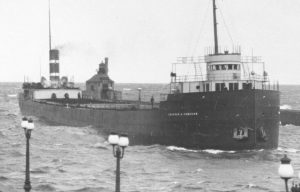Reviewer by Sharon Brunner
 Michael Schumacher in his book Too Much Sea For Their Decks brought to life the remarkable history of shipping on the Great Lakes. He clearly delineated the perils faced by captains and the crews of shipwrecked schooners, wooden freighters, steel-hulled steamers, passenger vessels, whalebacks, and bulk carriers. Some of the mishaps were well known, while others little known to forgotten, with one thing in common the loss of shipping and passenger vessels in the cold and vast waters of Lake Superior. Part of the lyrics of the song “The Wreck of the Edmund Fitzgerald” by Gordon Lightfoot included “Of the big lake they called Gitche Gumee / Superior, they said, never gives up her dead.” Lake Superior is the coldest and deepest of the Great Lakes, approximately 2,800 miles of coastline, 350 miles wide with an average depth of 500 feet. The Shipwreck Museum in Paradise, Michigan has paid tribute to many of the shipwrecks that have occurred on the Great Lakes. I have visited the museum on several occasions. I live in Sault Ste. Marie, Michigan and have seen many ships on the St. Mary’s River. I also have seen a multitude of them utilize the Soo Locks. Plenty of places in the Upper Peninsula of Michigan were mentioned in the book. Many of the shipwrecks described by Shumacher were the result of harsh weather, overloading of freight, hatch slip ups and other human and natural tragedies.
Michael Schumacher in his book Too Much Sea For Their Decks brought to life the remarkable history of shipping on the Great Lakes. He clearly delineated the perils faced by captains and the crews of shipwrecked schooners, wooden freighters, steel-hulled steamers, passenger vessels, whalebacks, and bulk carriers. Some of the mishaps were well known, while others little known to forgotten, with one thing in common the loss of shipping and passenger vessels in the cold and vast waters of Lake Superior. Part of the lyrics of the song “The Wreck of the Edmund Fitzgerald” by Gordon Lightfoot included “Of the big lake they called Gitche Gumee / Superior, they said, never gives up her dead.” Lake Superior is the coldest and deepest of the Great Lakes, approximately 2,800 miles of coastline, 350 miles wide with an average depth of 500 feet. The Shipwreck Museum in Paradise, Michigan has paid tribute to many of the shipwrecks that have occurred on the Great Lakes. I have visited the museum on several occasions. I live in Sault Ste. Marie, Michigan and have seen many ships on the St. Mary’s River. I also have seen a multitude of them utilize the Soo Locks. Plenty of places in the Upper Peninsula of Michigan were mentioned in the book. Many of the shipwrecks described by Shumacher were the result of harsh weather, overloading of freight, hatch slip ups and other human and natural tragedies.
The major themes covered in this book were harsh weather, difficult decisions, bravery, and greed. Harsh weather appeared to be one of the more prevalent problems. The weather may be calm without a threat of storms during the beginning of their voyages and then things would take a turn for the worse. Sometimes captains knew about a storm but decided to continue on their voyage. Captains had to make difficult decisions such as the maintenance of the ships under their supervision. A decision to add additional security to the hatches could end up with the ships’ demise. Many of the ships’ crews faced circumstances in which they demonstrated acts of bravery. It was difficult to imagine what was going through their minds when they knew their ship was sinking. Ships have sunk because of the heavy loads they carried, more than the ship could handle. Captains had to satisfy the owners of the shipping companies by trying to move freight as cost effective and quickly as possible, profit came before the safety of ships’ crew members.
 Schumacher provided amazing photographs in this book. For example, a picture of the Chester A. Congdon, a 532-foot freighter, appeared on page 91, taken May 31, 1918. He showed the same ship laden with wheat when it was split in two. He went as far back as 1875 with a Schooner named the Stranger that was shipwrecked at Grand Marais, Michigan. The hurricane of 1913 was clearly defined by Schumacher’s photographs and his narrative. I was surprised to learn about a hurricane that took place in Michigan. The main characters in the book included ship captains, the coast guard, deckhands, wheelsmen, mates, the people the ships were named after and bystanders. Schumacher revealed the difficult decisions ship captains had to make and the pressure they were under to accommodate the demands of the investors. How to accomplish this changed constantly. The Soo Locks served as the measuring stick for the shipping business. The number of ships that utilized the locks tripled during the decade between 1880 and 1890. Shipbuilders had to continue to put on their thinking caps to come up with the most cost effective vessels.
Schumacher provided amazing photographs in this book. For example, a picture of the Chester A. Congdon, a 532-foot freighter, appeared on page 91, taken May 31, 1918. He showed the same ship laden with wheat when it was split in two. He went as far back as 1875 with a Schooner named the Stranger that was shipwrecked at Grand Marais, Michigan. The hurricane of 1913 was clearly defined by Schumacher’s photographs and his narrative. I was surprised to learn about a hurricane that took place in Michigan. The main characters in the book included ship captains, the coast guard, deckhands, wheelsmen, mates, the people the ships were named after and bystanders. Schumacher revealed the difficult decisions ship captains had to make and the pressure they were under to accommodate the demands of the investors. How to accomplish this changed constantly. The Soo Locks served as the measuring stick for the shipping business. The number of ships that utilized the locks tripled during the decade between 1880 and 1890. Shipbuilders had to continue to put on their thinking caps to come up with the most cost effective vessels.
Captain Albert Stiglin manned the ship Steinbrenner. He watched the crew tighten the twenty-eight clamps on the Steinbrenner. He learned about stormy conditions, but he thought it was nothing too serious. The hatch covers were the old telescoping type, not watertight. He decided not to cover the hatches with tarps and fasten them down. Stiglin later regretted that decision. A horrible storm pounded the vessel with high waves and wind which assaulted the already weakened hatch covers. The pumps could not keep up with the influx of water. Captain Stiglin did everything possible to keep the freighter ahead of the storm’s clutches. Stiglin sounded the abandon ship whistle and the Steinbrenner sunk quickly after the crew departed the vessel. Stiglin’s decision to not add additional security to the hatches came under question.
I enjoyed learning more about Isle Royale. The island, located 17 miles from Grand Portage, Minnesota, is 45 miles long and nine miles wide. Schumacher made the comment that the island was the largest island on the inland seas. However, Manitoulin Island is the largest. Many animals have made the island their home. They came from Canada and traveled over the ice-covered Lake Superior. The island has unfortunately suffered a loss of wolves. Efforts are being made to repopulate the island with more wolves. Scientists have studied the predator-prey relationship of the wolf and moose populations on the island during previous times.
On July 17, 1956, an Italian flagship known as the Andrea Doria departed Genoa for a nine-day trip to New York City. I know this is not a Great Lakes ship but an account of an event a friend of mine experienced. Tom, my friend, was aboard the aforementioned ship when the shipwreck occurred. (Not going to give his last name.) The Stockholm, a Swedish ship, struck the Andrea Doria on the starboard side. The Stockholm remained seaworthy, but the Andrea Doria was fatally damaged. Unfortunately, 51 people lost their lives due to this tragedy. The crew on the Stockholm provided lifeboats as well as other ships that responded to the Andrea Doria’s SOS. Schumacher mentioned on several occasions when other ships came to the rescue of ships in trouble, which represented a form of camaraderie. Tom reported feelings of fear and confusion when he struggled to get dressed after hearing the warning siren. The collision occurred at approximately 11:00 that evening. He managed to get on a lifeboat after helping others and afterwards he boarded the Stockholm. Tom was returning to the United States from a trip to Rome for priesthood study. The cause of the accident was due to heavy fog.
Many books have been published about shipwrecks. The chapter about Cumberland and Cumberland Point reminded me of Alfred Lansing’s book Endurance: Shackleton’s Incredible Voyage. The Cumberland remained frozen in the ice and snow on the St. Mary’s River near Collinwood in 1871 until the spring thaw. Unlike the crew in Endurance, Cumberland’s crew was able to make it to shore. The book also reminded me of the 1997 movie Titanic that starred Leonardo DeCaprio and Kate Winslet. An underwater iceberg caused the ship to sink, a natural occurrence. Was the captain at fault?
I recommend Too Much Sea for Their Decks for its gripping rendition of the extraordinary history of Great Lakes shipping because of its poignant description of the perils of shipwrecks, because of the mysterious loss of many ships as they succumbed to Lake Superior’s depth and storms, the haunting stories of the crews’ bravery, and how Isle Royale served as a port in a storm. At the beginning of each chapter Schumacher gave information about the specifications of each vessel such as the length and type of vessel in a chronological manner. Therefore, he described the progression concerning the vessels to meet the needs of the growing market. Schumacker’s efforts to provide a factual and illuminating understanding of the various shipwrecks of the Great Lakes needs to be commended.



